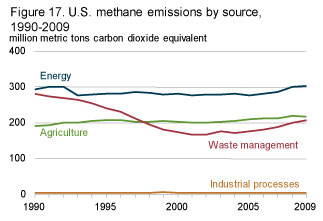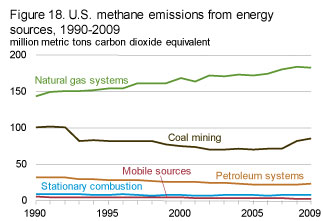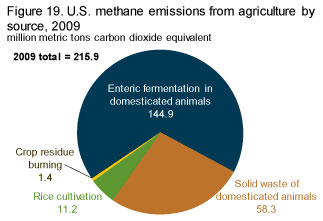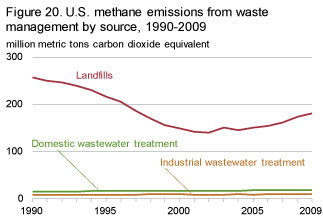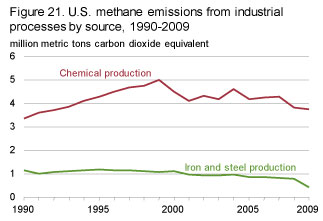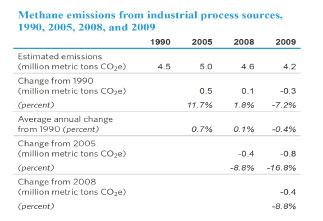3. Methane Emissions
3.1. Total emissions
The major sources of U.S. methane emissions are energy production, distribution, and use; agriculture; and waste management (Figure 17). U.S. methane emissions in 2009 totaled 731 MMTCO2e, 0.9 percent higher than the 2008 total of 724 MMTCO2e (Table 17).
Methane emissions declined steadily from 1990 to 2001, as emissions from coal mining and landfills fell, then rose from 2002 to 2009 as a result of moderate increases in emissions related to energy, agriculture, and waste management that more than offset a decline in industrial emissions of methane over the same period.
The energy sector—including coal mining, natural gas systems, petroleum systems, and stationary and mobile combustion—is the largest source of U.S. methane emissions, accounting for 303 MMTCO2e in 2009. Agricultural emissions (primarily from livestock management) and emissions from waste management (primarily landfills) also are large sources of U.S. methane emissions, contributing 216 and 208 MMTCO2e, respectively, in 2009.
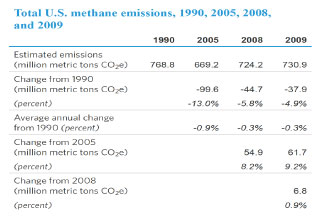
3.2. Energy sources
Natural gas systems and coal mines are the major sources of methane emissions in the energy sector (Figure 18 and Table 18). U.S. methane emissions from natural gas systems grew from 1990 to 2009 by 27 percent (39 MMTCO2e), largely because of increases in natural gas consumption. Emissions from coal mines declined from 1990 to 2002 and remained nearly steady through 2007. In 2009, emissions from ventilation and degasification systems at underground mines increased by 9.2 percent, leading to a 4.8-percent increase in total net emissions from coal mining over the 2008 level, despite declines in emissions from both surface mining and post-mining activities.
With domestic oil production dropping by 28 percent from 1990 to 2009, methane emissions from petroleum exploration and production have declined by the same percentage.
Residential wood consumption accounted for just over 45 percent of U.S. methane emissions from stationary combustion in 2009.
Methane emissions from passenger cars fell by 77 percent from 1990 to 2009, as the use of catalytic converters increased. An 11-percent drop from 2001 to 2009 in annual miles traveled by passenger cars also contributed to the decrease in emissions.
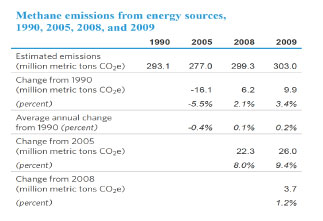
3.3. Agricultural sources
Livestock management—including emissions from enteric fermentation (67 percent) and management of animal waste (27 percent)—accounts for the largest share of U.S. methane emissions from agricultural activities (Figure 19 and Table 19). Since 1990, there has been a shift in livestock management to larger facilities that manage waste in liquid systems, increasing the amount of methane generated from livestock waste. Increases in the U.S. swine population since 1990 have also contributed to the rise in methane emissions. Emissions of methane from animal waste fell by 1.7 percent from 2008 to 2009. Swine accounted for 42 percent (25 MMTCO2e), and dairy cattle accounted for 49 percent (28 MMTCO2e), of total methane emissions from livestock manure in 2009.
Enteric fermentation (food digestion) in ruminant animals also produces methane emissions, and digestion by cattle accounts for 96 percent of U.S. methane emissions from this source. With little change in the cattle population since 1990, the level of emissions from enteric fermentation has been relatively stable, with a small decrease of 3 MMTCO2e (2.2 percent) in 2009 from the 2008 level.
Methane emissions from rice cultivation in the United States increased by almost 4 percent (0.4 MMTCO2e) from 2008 to 2009.
Emissions from crop residue burning increased by 4 percent from 2008 to 2009. Residue burning remains the smallest contributor to methane emissions from agriculture, representing less than 1 percent of total U.S. methane emissions from agriculture.
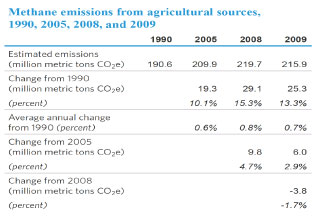
3.4 Waste management sources
Methane emissions from waste management are dominated by the decomposition of solid waste in municipal and industrial landfills (Figure 20 and Table 20). Emissions from landfills declined substantially from 1990 to 2001 as a result of increases in recycling and in the recovery of landfill methane for energy; since 2001, increases in the total amount of waste deposited in landfills have resulted in annual increases in methane emissions. The rapid growth in methane recovery from landfills during the 1990s can be traced in part to the Federal Section 29 tax credit for alternative energy sources, which provided a subsidy of approximately 1 cent per kilowatthour for electricity generated from landfill gas before June 1998. The U.S. EPA's New Source Performance Standards and Emission Guidelines, which require large landfills to collect and burn landfill gas, have also played an important role in the growth of methane recovery. In addition, the American Recovery and Reinvestment Act of 2009 included a 2-year extension (through December 31, 2012) of the production tax credit for renewable energy, including waste-to-energy and landfill gas combustion.
Wastewater treatment, including both domestic wastewater (about two-thirds) and industrial wastewater (about one-third), is responsible for 14 percent (28 MMTCO2e) of methane emissions from waste management. In 2009, emissions from wastewater treatment at pulp and paper manufacturing facilities accounted for 47 percent (5 MMTCO2e) of total emissions from industrial wastewater, and emissions from meat and poultry packing facilities accounted for another 41 percent (4 MMTCO2e).
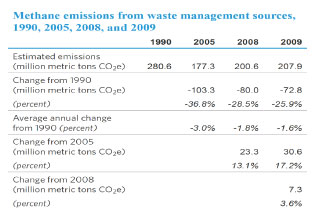
3.5. Industrial process sources
Methane emissions are generated by industrial processes in the production of iron and steel and chemicals (Figure 21 and Table 21). Total methane emissions from industrial processes declined by a net 0.4 MMTCO2e (9 percent) from 2008 to 2009, as a result of declines in both chemical production and iron and steel production. Similarly, large decreases during 2009 in production of pig iron, coke, and sinter associated with iron and steel production caused methane emissions from this industrial source to drop by 43.6 percent (0.3 MMTCO2e) from the 2008 level.
In 2009, methane emissions from industrial processes dropped below 1990 levels for the first time, resulting in a net decline of 0.3 MMTCO2e (7.2 percent) over the past two decades; however, the 2009 decline is associated with the impact of the recession on industrial production in 2009, and emissions from industrial processes can be expected to rebound as the U.S. economy recovers.

